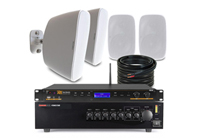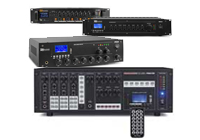Commercial Audio Systems
100v line PA systems designed for installation into commercial premises such as offices, stores and warehouses.
Read More-
Vonyx VD715A 15" Active PA Speaker with DSP - 900WRegular Price £309.00 Special test Price £259.00
- 15-inch LF woofer with 2.5-inch voice coil
- 900W class D bi-amplification for clarity and accuracy
- Bluetooth 5.0 connectivity with True Wireless Stereo (TWS)
- 4 DSP audio presets: Normal, DJ, Monitor, Speech
- 0°/5° dual-angle speaker pole mount design
In stockRegular Price £309.00 Special test Price £259.00Free delivery and weekend delivery available
In stock -
Vonyx ST100 Portable PA System with CD, Bluetooth + Wireless Mics£389.00
- All-in-one 250W speaker with CD, MP3, and Bluetooth streaming
- Comprehensive microphone set: 1 wired, 2 wireless UHF included
- Battery-powered and mains operation for versatile usage anywhere
- Built-in audio controls including echo, delay and equalisation
- Portable design with telescopic handle, wheels, and tripod mount
In stockIn stock -
Vonyx VSA700-BP 15" Portable PA System with Wireless Mic & HeadsetRegular Price £349.00 Special test Price £219.00
- Powerful 1000W portable speaker system
- Wireless connectivity with built-in Bluetooth streaming
- Long-lasting battery life provides up to 8 hours continuous play
- UHF handheld microphone and wireless bodypack mic included
- Sturdy transport wheels and handy pull-up carry handle
In stockRegular Price £349.00 Special test Price £219.00Free delivery and weekend delivery available
In stock -
Vonyx ST180 Portable PA System with CD, Bluetooth + Wireless Mics£549.00
- Portable PA Speaker: Easy transport with wheels & telescopic handle
- Battery Powered PA System: Operate without mains for 4-8 hours
- Includes slot-in CD player with anti-shock protection
- Integrated Bluetooth audio streaming & USB/SD playback
- Comes with 2 wireless UHF mics plus 1 wired mic & remote control
In stockIn stock -
Vonyx VSA500-BP 12" Portable PA System with Wireless Mic & HeadsetRegular Price £289.00 Special test Price £189.00
- Portable PA system with 800W output for powerful sound performance
- Includes wireless UHF microphone and headset combo for versatile usage
- Integrated battery providing up to 8 hours continuous use
- Multiple playback options including Bluetooth, USB, SD and AUX
- Easy transport design with wheels and extendable handle
In stockRegular Price £289.00 Special test Price £189.00Free delivery and weekend delivery available
In stock -
Vonyx VSA700 15" Portable PA System with 2x Wireless Mics - 1000WRegular Price £319.00 Special test Price £259.00
- Complete portable speaker system with wireless microphones
- Active design with Class-D amplification and 1000W max output
- Integrated Bluetooth, USB and SD connectivity options included
- Built-in rechargeable battery providing 8 hours of continuous use
- Two UHF wireless microphones with independent mic control
In stockRegular Price £319.00 Special test Price £259.00Free delivery and weekend delivery available
In stock -
Vonyx VSA500 12" Portable PA System with 2x Wireless Mics - 800WRegular Price £279.00 Special test Price £219.00
- Portable PA Speaker with built-in rechargeable battery
- 800W max output with high performance class D amplifier
- Includes two wireless UHF microphones
- Bluetooth, USB, SD and AUX input options for versatile playback
- Built-in trolley wheels and handle for portability ease
In stockRegular Price £279.00 Special test Price £219.00Free delivery and weekend delivery available
In stock -
Vonyx MEG075 Premium Portable Megaphone Loudhailer - 75W Black£70.00
- Clear voice projection and siren alert function
- MP3 playback via USB, SD card, and Aux input
- Bluetooth wireless technology for audio streaming
- Rechargeable Li-Ion battery including USB charger
- Ergonomic pistol grip and adjustable carry strap
In stockIn stock -
Vonyx MEG150 Premium Portable Megaphone Loudhailer - Megaphone 200W£199.00
- Portable megaphone, lightweight design with ergonomic grip
- 200W peak output delivers clear audio over 2km range
- MP3 player, USB, SD inputs, and wireless BT streaming capability
- Integrated Li-Ion battery with built-in charger for extended use
- Siren alarm function and included hand microphone with controls
In stockIn stock -
Vonyx MEG050 Portable Megaphone Loudhailer with LED Light - 50W£47.99
- Clear broadcast range up to 1000m, ideal for crowd control.
- Portable megaphone design with ergonomic pistol grip.
- Built-in front-positioned LED light for improved visibility.
- Flexible media playback: USB, MicroSD, Aux-in, and BT streaming.
- Unique recording functionality for messages and announcements.
In stockIn stock -
PD BHW40BK 4" Wall Mount Speaker Pair - In/Outdoor BlackRegular Price £109.00 Special test Price £89.00
- Pair of Weatherproof IPX5-rated speakers
- Ideal for outdoors and indoors
- Adjustable switch for 100V or 8 Ohm operation
- Two way speaker system with crossover network
- Aluminium marine grade grille
In stockRegular Price £109.00 Special test Price £89.00Free delivery and weekend delivery available
In stock -
Power Dynamics PDY215SA 15" Active PA Subwoofer - 900WRegular Price £449.00 Special test Price £413.08
- 15-inch 900W active PA subwoofer
- XLR balanced full-range and high-pass outputs
- Adjustable crossover frequency and phase switch
- RCA, 6.3mm Jack, and balanced XLR inputs
- Sturdy coated plywood housing with side handles
In stockRegular Price £449.00 Special test Price £413.08Free delivery and weekend delivery available
In stock -
PD BHW30WH 3" Wall Mount Speaker Pair - In/Outdoor White£71.99
- Suited for indoor and outdoor use
- IPX5-rated pair of weatherproof wall loudspeakers
- Adjustable switch for 100V or 8 Ohm operation
- Two-way speaker system with crossover network
- Aluminium marine grade grille
In stockIn stock -
Power Dynamics PDY218S 18" Passive PA Subwoofer - 1000WRegular Price £359.00 Special test Price £344.64
- Powerful passive PA subwoofer
- 1000W maximum output
- Built-in 18-inch woofer
- Features passive and passive bi-amplified modes
- User-friendly and robust design
In stockRegular Price £359.00 Special test Price £344.64Free delivery and weekend delivery available
In stock -
PD BHW50BK 5.25" Wall Mount Speaker Pair - In/Outdoor Black£125.00
- Weatherproof IPX5 wall loudspeaker pair
- Adjustable rotary switch for 100V or 8 Ohm operation
- Two-way speaker system with crossover network
- Aluminium marine grade grille
- Easy installation with click-on wall bracket
In stockIn stock -
2x Power Dynamics CSPS6 16 Ohm Ceiling Speaker - 6.5"£28.00
- Set of two 6.5” in-ceiling speakers
- 16 Ohm design
- Classic white finish
- 40W max output each
- Easy fit spring clamps
In stockIn stock -
PD BHW40WH 4" Wall Mount Speaker Pair - In/Outdoor White£109.00
- IPX5 pair of eatherproof wall speakers
- Suitable for outdoor and indoor use
- Adjustable switch for 100V or 8 Ohm operation
- Two-way speaker system with crossover network
- Aluminium marine grade grille
In stockIn stock -
Power Dynamics PDY218SA 18" Active PA Subwoofer - 1000W£509.00
- 18-inch 1000W active subwoofer
- Full-range and high-pass balanced XLR outputs
- Switchable phase control and an adjustable crossover
- 6.3mm Jack, RCA, and balanced XLR inputs
- Sturdy coated plywood housing with side handles
In stockIn stock -
4 x ICS8 Indoor Column Speaker System£509.00
- Multi-zone outdoor speaker system
- Water-resistant housed column speakers can be permanently installed inside or outside
- Multi-zone amplifiers allows speakers to be installed in up to 4 different rooms
- Integrated media player with Bluetooth connectivity and inbuilt MP3 player
- Full-range speakers with 5 high-quality speaker drivers in each unit for detailed background sound
In stockIn stock -
Power Dynamics PDY2215S 2x15" Passive PA Subwoofer - 1800W£519.00
- 1800W passive PA subwoofer
- Features dual 15-inch drivers
- Maximum output power 1800W
- Includes passive and passive bi-amplified modes
- Heavy-duty build with extra hard speaker coating
In stockIn stock -
Vonyx VM-KG08 8-Channel PA Mixer, USB Audio Interface, Bluetooth & DSP£149.00
- Multifunctional 8-channel mixing desk
- USB connection to laptops and PCs for recording
- 99 pre-programmed DSP effects built-in
- Bluetooth connectivity to pair smartphones and tablets
- Combi line/mic inputs and +48V phantom power
In stockIn stock -
PD PDM-Y601 6-Channel PA Music Mixer with Bluetooth & MP3£99.00
- Six-channel PA mixer
- Includes four jack/XLR combo inputs
- Integrated 24-bit, 48kHz digital signal processor with 99 effects
- Features built-in USB player for MP3 or PC connectivity
- Bluetooth enabled for wireless streaming
In stockIn stock -




























